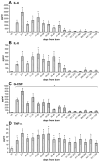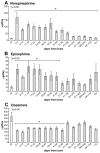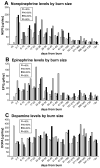Extent and magnitude of catecholamine surge in pediatric burned patients
- PMID: 20407405
- PMCID: PMC2858869
- DOI: 10.1097/SHK.0b013e3181b92340
Extent and magnitude of catecholamine surge in pediatric burned patients
Abstract
Increased catecholamine (CA) levels after severe burn are associated with stress, inflammation, hypermetabolism, and impaired immune function. The CA secretion profiles in burned patients are not well described. Mechanisms, duration, and extent of CA surge are unknown. The purpose of this large unicenter study was to evaluate the extent and magnitude of CA surge after severe burn in pediatric patients. Patients admitted between 1996 and 2008 were enrolled in this study. Twenty-four-hour urine collections were performed during acute hospitalization and up to 2 years postburn. Results from the samples collected from 12 normal, healthy volunteers were compared with the data from the burned patients. Relevant demographic and clinical information was obtained from medical records. Student t-test and one-way ANOVA were used to analyze the data where appropriate. Significance was accepted at P < 0.05. Four hundred thirteen patients were enrolled in this study; 17 patients died during acute hospitalization. Burn caused a marked stress and inflammatory response, indicated by massive tachycardia and elevated proinflammatory cytokines. In burned patients, CA levels are consistently and significantly modulated after burn when compared with the levels in normal, healthy volunteers. Catecholamine levels were significantly higher in boys compared with girls, correlated with burn size in burns greater than 40%, and were increased in older children. There were differences over time in survivors versus nonsurvivors, with CA levels significantly higher in nonsurvivors at two time points. Inflammatory cytokines show a similar profile during the study period. Our study gives clinicians a useful insight into the extent and magnitude of CA elevation to better design treatment strategies.
Figures







References
-
- Sabban EL. Catecholamines in stress: molecular mechanisms of gene expression. Endocr Regul. 2007;41:61–73. - PubMed
-
- Ballard-Croft C, Maass DL, Sikes P, White J, Horton J. Activation of stress-responsive pathways by the sympathetic nervous system in burn trauma. Shock. 2002;18:38–45. - PubMed
-
- Takahashi H, Kobayashi M, Tsuda Y, Herndon DN, Suzuki F. Contribution of the sympathetic nervous system on the burn-associated impairment of CCL3 production. Cytokine. 2005;29:208–214. - PubMed
-
- Takahashi H, Tsuda Y, Kobayashi M, Herndon DN, Suzuki F. Increased norepinephrine production associated with burn injuries results in CCL2 production and type 2 T cell generation. Burns. 2004;30:317–321. - PubMed
-
- Norbury WB, Jeschke MG, Herndon DN. Metabolism modulators in sepsis: propranolol. Crit Care Med. 2007;35:S616–620. - PubMed
Publication types
MeSH terms
Substances
Grants and funding
LinkOut - more resources
Full Text Sources
Medical

